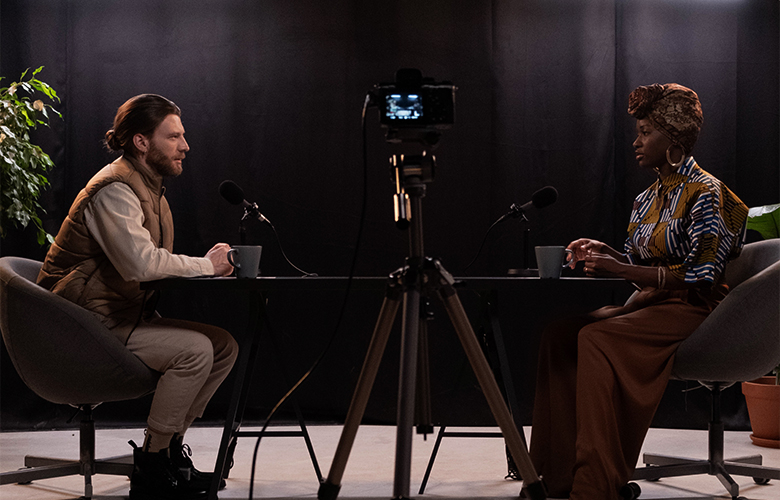
The pandemic has caused a new challenge to come to the forefront for theater artists – the intersection of art and technology. Theatermakers have been using digital engagement for years but with the inability to gather in person, theater’s digital revolution has accelerated dramatically. Commercial, nonprofit and government subsidized arts organizations and individuals around the world have had to step up their best tech and entrepreneurial skills just to survive. The good news is that the technology, software, hardware and support keeps getting better. Here are some things to consider as you navigate the art, technology and digital engagement landscape.
Digital content or digital media is already part of your everyday life; videos, audio, photos, blogs, vlogs, podcasts, basically anything that is digital data. Most individuals and organizations are already using some form or digital content to engage with their audience. Zazzle Media did a great list of 101 Different Types of Digital Content (click to access the list). The costs of these vary greatly and so do the results. One of the most expensive types of digital engagement are livestreams and digital captures of full productions: more on those to follow.
Digital content is a marketing asset to let your audience/fanbase know where you are and what you’re doing. Digital content is used to raise money or to build awareness or a combination of both. Digital content is a way to sell tickets, solicit donations or just build awareness of your show or organization. Full length live streams and digital captures can be a product in and of itself which in turn creates awareness of your organization, a particular show or an individual artist. The key is balancing the budget. Short form video, audio, blogs, etc can be extremely effective for awareness and brand building but difficult to monetize. Long form video like live streams and digital captures can create awareness and generate revenue but it’s a highly competitive market and doing it poorly can damage your organization’s image and lose lots of money. Set clear goals and budgets. The power of digital engagement is that you can get metrics and analytics in real time to evaluate effectiveness. Open rates for emails, comments, shares and likes on your social media platforms, numbers or views of your streaming or on-demand content, time spent on your website, downloads of apps are just a few of the ways to measure customer/audience engagement. For organizations and theaters, your marketing department or outsourced marketing partners should be able to navigate through these strategies. For individual artists and performers, its crucial to learn the most effective path to reaching your audience/fanbase.
“Digital capture” or “live capture” is the industry term referring to the recording by film or video of a stage production. Digital capture is usually done in the theater while the audience is watching the show to create a sense of going to the theater. The recording is of the full show and done in real time. A digital capture is one type of digital content and can be the most expensive type of single asset.
A “live stream” is an event that is broadcast on the internet while it happens in real time. The event is recorded at the same time that it is broadcast, the subsequent video viewed later is called on demand video, or the digital capture or live capture on demand, or scheduled video (if it is only available at a certain time). The subsequent recorded video screenings can be referred to as the “encore” presentations.
Just because you have secured the rights or permission to do a live stage show that doesn’t mean that you have the rights to live stream or record the show. Streaming or recording individual songs or scenes also requires rights , as does video recorded for archival or educational purposes. ASCAP, BMI or SESAC may cover some music clearances/rights for a livestream but in no way guarantee that you have the rights for your venue or event. Even if you are not using union members, you still need documented permissions and rights. Theatrical licensing agencies like MTI and TRW have partnered with ticketing companies to help with rights and royalty collection. It is always best to get legal advice when you are unsure. In April 2020, APAP (Association of Performing Arts Professionals) presented a panel of experts giving advice and a offering a presentation deck on the The Legal Landscape of Live Streaming
Think of digital content like indie movies. Short films can be entertaining, they generally cost less to produce but they have limited upside, meaning that they will have less distribution possibilities and there is less money to be made. But short films can win awards and create awareness of the writers, directors and actors to propel them to Hollywood and bigger upside. Short form content can be very effective to engage your audience. It is a sample of what you do and an enticement to donate or come see your shows live in your theater where you can charge higher ticket prices. Keep in mind that you are a theater organization or individual that has a core mission to produce live stage shows, you’re not in the business of producing movies and tv.
The full length streams and digital captures are also like indie movies. If you decide to try to live stream every show it’s very costly and if you try to do an inexpensive shoot, you may not be doing justice to the live stage show, the authors or the audience. Your audience may tune in at first but with poor quality content or live streaming, they may not return.
Live streams can be done very inexpensively with Zoom type readings, talkbacks, or lectures and be effective in engaging the audience or fanbase that you have built.
Again, the indie movie analogy works best for digital captures or live streams of the full length content. You can use cell phones, rent or buy expensive HD or 4K cameras to live stream or capture the show. Costs can be minimal to millions depending on the unions, venues, etc. It’s best to make a budget, and get projections for how many viewers you can get and what they are willing to pay.
Focus on what is sustainable and what will remain as your core mission after the world reopens. If you are a theater or live stage producing entity and your main business will still be live in person entertainment after the pandemic make sure you are spending money, resources and efforts on returning to that business model. I believe that many theaters will offer a hybrid of tickets to live and virtual shows in their theaters but don’t spend money on video equipment meant for a movie studio at the expense of upgrading your HVAC system. The video side of your live theater business may be a loss leader so budget accordingly. Master the less expensive digital content before taking risks with high ticket items like full length digital captures and live streams of fully staged productions.
How Many Producers Does it Take to Make a Broadway Musical?
COVID-19 and the Opportunity for a Gender Parity Reset and More


Bonnie Comley is a three-time Tony Award-winning producer. She has won an Olivier Award and two Drama Desk Awards for her stage productions. She is a member of The Broadway League and serves on their Audience Engagement and Education Committee. Comley has produced over 40 films, winning four Telly Awards and one W3 Award. She is the founder and CEO of BroadwayHD, the world’s premier online streaming platform delivering over 300 premium live productions to theatre fans globally. The theatre community has honored Comley for her philanthropic work; she is the recipient of The Actors Fund Medal of Honor, The Drama League Special Contribution to the Theater Award, The Paul Newman Award from Arts Horizons and The Theater Museum Distinguished Service Award. Comley’s educational honors include The Distinguished Alumni Award from Emerson College and The Distinguished Alumni Award from the University of Massachusetts and the business honor society Beta Gamma Sigma. The Music Theatre Program at Boston University is named in her honor, The Musical Theatre Society Room at Emerson College bears her name, the 500-seat theater at the University of Massachusetts Lowell is known as the Comley-Lane Theatre, and The Stewart F. Lane and Bonnie Comley Stage is housed withi the Booth Arts Complex in Boston. Comley has been a keynote speaker or panelist at BroadwayCon, C2E2 (Chicago ComicCon), SXSW, Theatre Resources Unlimited (TRU), Crain’s New York Arts and Culture Webcast and City National Bank Women Entrepreneurs, and taught masterclasses or guest lectured at Columbia University, New York University, Emerson College, NYFA, Five Towns College and UMass, among others.
Read Full Profile© 2021 TheatreArtLife. All rights reserved.

Thank you so much for reading, but you have now reached your free article limit for this month.
Our contributors are currently writing more articles for you to enjoy.
To keep reading, all you have to do is become a subscriber and then you can read unlimited articles anytime.
Your investment will help us continue to ignite connections across the globe in live entertainment and build this community for industry professionals.